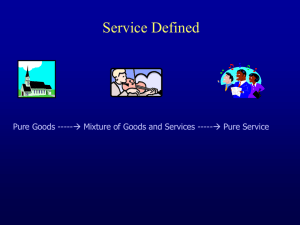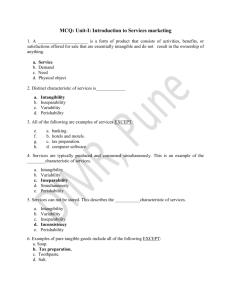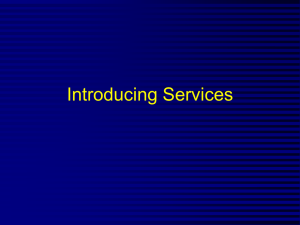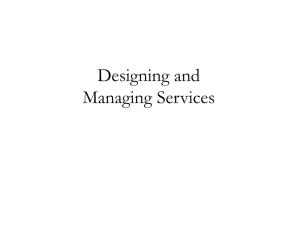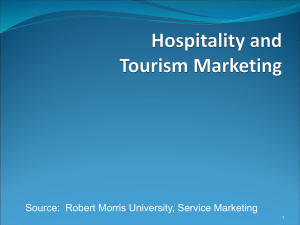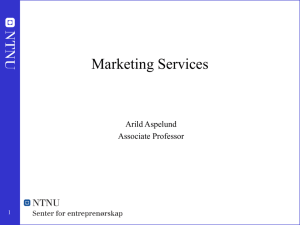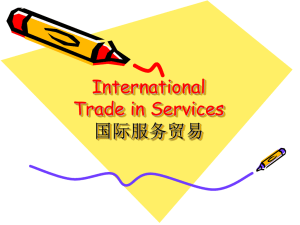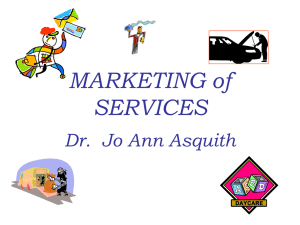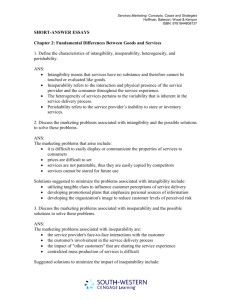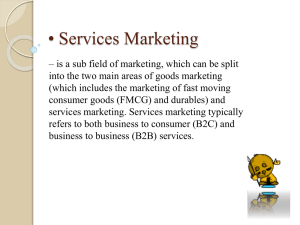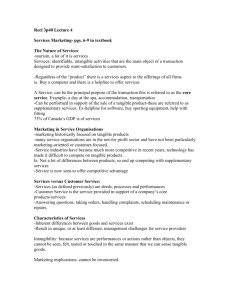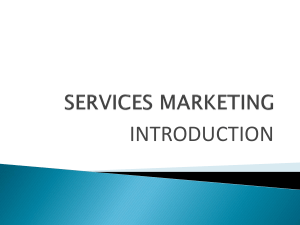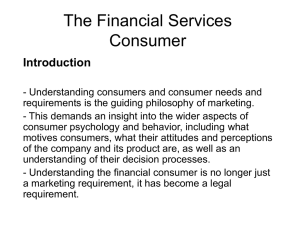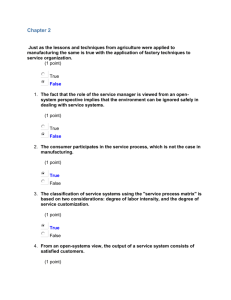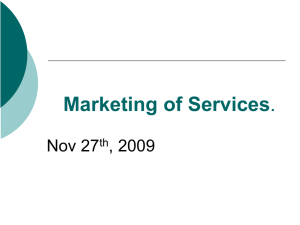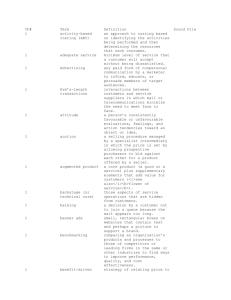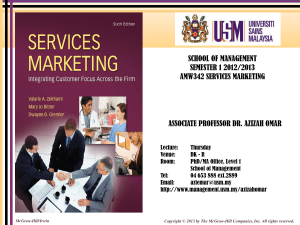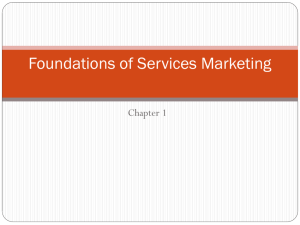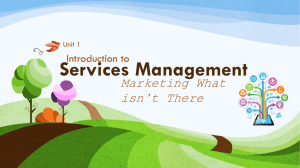eMM05
advertisement
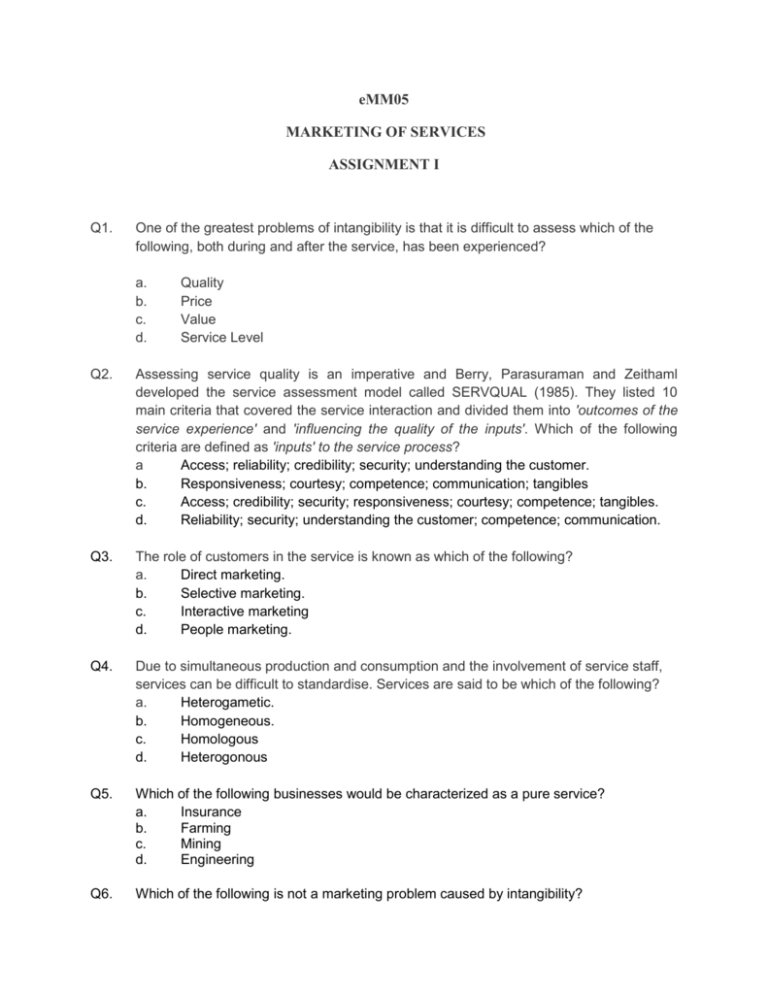
eMM05 MARKETING OF SERVICES ASSIGNMENT I Q1. One of the greatest problems of intangibility is that it is difficult to assess which of the following, both during and after the service, has been experienced? a. b. c. d. Quality Price Value Service Level Q2. Assessing service quality is an imperative and Berry, Parasuraman and Zeithaml developed the service assessment model called SERVQUAL (1985). They listed 10 main criteria that covered the service interaction and divided them into 'outcomes of the service experience' and 'influencing the quality of the inputs'. Which of the following criteria are defined as 'inputs' to the service process? a Access; reliability; credibility; security; understanding the customer. b. Responsiveness; courtesy; competence; communication; tangibles c. Access; credibility; security; responsiveness; courtesy; competence; tangibles. d. Reliability; security; understanding the customer; competence; communication. Q3. The role of customers in the service is known as which of the following? a. Direct marketing. b. Selective marketing. c. Interactive marketing d. People marketing. Q4. Due to simultaneous production and consumption and the involvement of service staff, services can be difficult to standardise. Services are said to be which of the following? a. Heterogametic. b. Homogeneous. c. Homologous d. Heterogonous Q5. Which of the following businesses would be characterized as a pure service? a. Insurance b. Farming c. Mining d. Engineering Q6. Which of the following is not a marketing problem caused by intangibility? a. b. c. d. Services lack the ability to be stored. Services are difficult to price Services are difficult to communicate to customers. Services lack patent protection Q7. The unique services characteristic that reflects the inter connection between the services firm and its customers is called. a. Intangibility b. Inseparability c. Heterogeneity d. Perishability Q8. The fact that services are sold and then produced and consumed simultaneously is attributed to. a. Intangibility b. Inseparability c. Perishability d. Heterogeneity Q9. Which of the following is not an advantage of standardized services? a. Less expensive b. Meets the customers exact needs c. Delivered faster. d. More consistent Q10. Which of the following strategies is used to alter consumer demand? a. Increasing consumer participation. b. Utilizing creative pricing strategies. c. Sharing capacity d. Utilizing third parties. Q11. It is generally accepted that the ___________________ includes the ‘soft part’ of the economy consisting of several sub sectors. a. Services economy b. Industrial economy c. Information economy d. Agricultural economy Q12. The world’s largest industry in private sector and highest projected generator of jobs is: a. Business sector b. Retail c. Health Services d. The Hospitals Q13. The correct order of services in terms of highly tangible to highly intangible is a. Automobile, Ad Agencies, Fast Food Outlets, Teaching. b. Teaching, Ad Agencies, Fast Food Outlets, Automobiles c. Automobiles, Fast Food Outlets, Ad Agencies, Teaching d. Ad Agencies, Teaching, Fast Food Outlets, Automobiles Q14. Which of the following offers the best opportunity for an airline to recover from service failure associated with a cancelled flight? a) Customer service team at head office. b) Rapid diagnosis of customer needs and appropriate solution to problem. c) Money-off vouchers for future use. d) Letter of apology from the airline Chief Executive. Q15. Which of the following is not generally accepted as being part of the extended marketing mix for services? a) Product b) Price c) Process d) Practice Q16. Compared with low-contact services, customers of high-contact services are more likely to judge service quality on the basis of: a) Price of the service b) Processes used in carrying out the service c) Intangible outcomes, e.g. the performance of an investment portfolio d) Tangible outcomes Q17. In international services marketing, ____________ is the approach that aims to achieve uniformity in service delivery wherever it is consumed; whereas ___________ aims to develop ad deliver services as a tailor-made solution to the customer. a) Reactive; Proactive b) Proactive; Reactive c) Standardization; Customization d) Customization; Standardization Q18. In the absence of a physical product, service providers need to consider the use of ______________ that enable customers to make a judgment on the service quality. a) Intangible cues b) Tangible cues c) Blueprint d) Performance measures Q19. The providers of services with ___________________ can normally rely on export and import agents to manage the international service delivery without getting directly involved in the process. a) high degree of tangibility b) high degree of customization c) low degree of tangibility d) low degree of standardization Q20. Which are the factors or elements of internal marketing within a service firm a. Training of the staff that deal directly with the customers (front-line staff). b. Investment in staff training and development programmes c. Ensuring effective teamwork d. Ensuring that all employees are customer oriented. e. All of the above. Q21. Why is service differentiation so difficult to achieve? a. Difficult to achieve accurate comparative analysis. b. Service innovations can be patented and thus secured. c. Service intangibility and inseparability mean that customers are rarely able to compare alternative services in advance of purchase. d. Service is indispensable Q22. How can firms differentiate their service delivery? a. Implement the appropriate service delivery mechanism to improve customer service and effectiveness. b. Customer focused training and development of all staff. c. Create an attractive environment and ambience to project superior service. d. Ensure reliable and effective customer contact between staff and customers e. Employ enthusiastic people to interface with the customer. Q23. A tool for assessing the level of service quality based on the difference between users expectations and the service experience delivered is: a. the information value model. b. the service quality gap model. c. the balanced scorecard d. the service dashboard Q24. The element of service quality which is defined as 'the knowledge and courtesy of employees and their ability to convey trust and confidence'. a. Assurance. b. Reliability. c. Responsiveness d. Empathy. Q25. The element of service quality which is defined as 'a willingness to help customers and provide prompt service'. a. Empathy. b. Assurance. c. Reliability. d. Responsiveness. Q26. Bar coding and checkout scanner technology have created a wealth of consumer-buying information that can be used to target customers with precision. This process is an example of: a. service development b. micromarketing c. d. data envelopment analysis point of sale 27. Using the dimensions of strategic focus and competitive use of information, we can identify four strategic roles of information. Which of the following is not a strategic role of information? a. Create barriers to entry b. Generate revenue c. Create a data base asset d. Provide global communications 28 Services can create barriers to entry by: a. using economies of scale b. creating switching costs c. using databases and information technology d. all of the above 29. The nature of the service act depends on to whom or to what the service is directed and the degree of "tangibility" of the service provided. An example of a tangible service directed to the possessions of a customer would be a. a stay in a hotel. b. an investment advising session c. a fortune-telling session d. a full-service car wash. 30 Place the McDonald's fast food chain within the following matrix: a. b. c. d. Point A Point B Point C Point D 31 Which one of the following is not an example of a high customer contact service? a. Dry cleaning b. Banking c. School d. Hotel 32 Service processes can be classified according to each of the following, except: a. b. c. d. the degree of customer satisfaction the degree of customer contact. the object of the service activity defined as goods, information or people the degree of divergence ranging from standard to customized service 33. The term "customer contact" refers to: a. the handling of the product by the customer. b. the influence the customer has on service design c. the amount of time spent waiting in the system d. the physical presence of the customer in the system 34 A service blueprint can be used for all but one of the following: a. educate customers b. identify areas of service improvement c. maintain the level of service complexity and divergence d. identify points where moments of truth will occur 35 The new service development process cycle contains all but one of the following activities: a. idea generation b. analysis c. development d. full launch 36 An automatic teller machine would be considered a ________ robot. a. numerical control b. playback c. variable sequence d. fixed sequence 37 A "moment of truth" is not: a. an opportunity to influence a customer's perception of the service quality. b. critical in achieving a reputation for superior quality c. when the customer is forming an opinion about the efficiency of the service d. an interaction between a customer and a service provider 38. The most important attribute of customer contact personnel is: a. Education b. Sales related knowledge c. intelligence. d. empathy for the customer. 39 In an organization that has empowered its front-line employees, the middle managers become: a. obsolete b. facilitators c. inspectors d. supervisors 40. Which of the following occurrences would be considered a “moment of truth” in a restaurant setting? a. b. c. d. A diner considering the amount of tip to leave A child telling his parent what item on the menu looks good A waiter telling the cook what he really thinks of the manager A receptionist assigning a table to a customer 41 In the context of the service encounter triad, the trade-off between the service organization and the contact personnel is one of a. efficiency verses satisfaction b. efficiency verses autonomy c. perceived control d. autonomy versus satisfaction 42 The purpose of differential pricing is to: a. make peak period usage unattractive b. make off-peak usage attractive c. charge customers according to their ability to pay. d. adjust capacity to demand 43. The strategy of partitioning demand is feasible only when: a. demand is not from a homogeneous source b. demand is cyclic and predictable c. arrivals for service are random d. making appointments is impossible 44 Which of the following is not a strategy for managing supply? a. Developing complementary services b. Using part-time employees c. Forecasting demand d. Scheduling shifts 45. Which of the following is not a strategy to manage demand? a. Cross-training employees b. Offering price incentives c. Developing reservation systems d. Partitioning demand 46. Faced with variable demand and a perishable capacity, a service manager can smooth demand by: a. using part-time help during peak hours b. scheduling work shifts to vary workforce needs according to demand c. increasing the customer self-service content of the service d. using reservations and appointments 47 The customer is a(n) ________ in the service process and his/her impression of the service quality is influenced by many __________ . a. observer/perceptions b. observer/observations c. participant/perceptions d. participant/observations 48 Which of the following retail service scapes would best support an upscale store image? a. stark tile floors b. exposed, bright lighting c. store personnel waiting at cash registers d. well-spaced, lightly stocked shelving 49 Facility layout is discussed with attention to traffic flow, space planning and one of the following: a. need to avoid unnecessary travel b. eliminating bottlenecks c. aesthetic factors d. cost of providing service 50 Removing the kitchen from fast-food outlets to a central location gives all of the following benefits, except: a. reduction in waste b. consolidation of demand c. shorter customer wait times d. make-to-order customization
